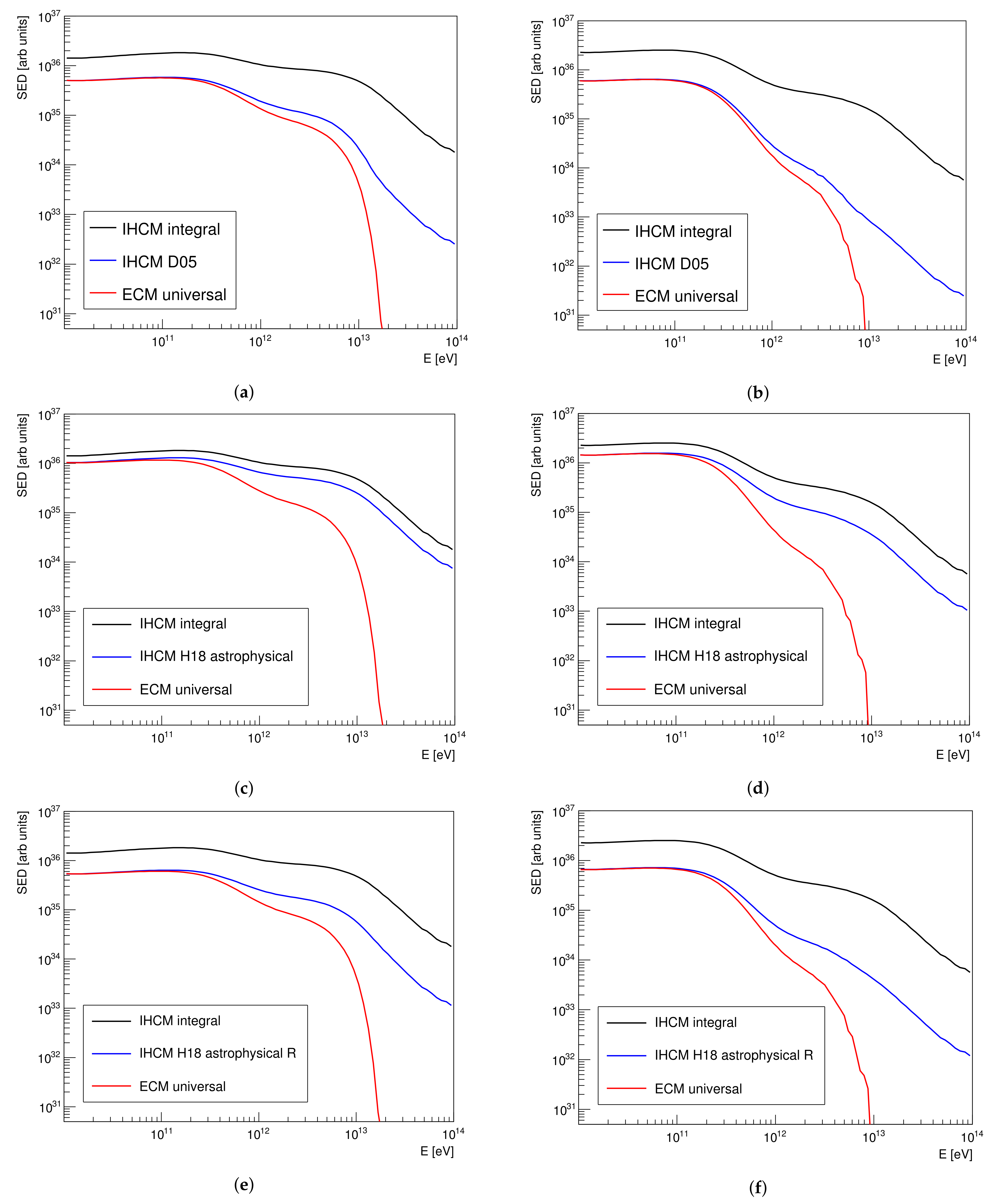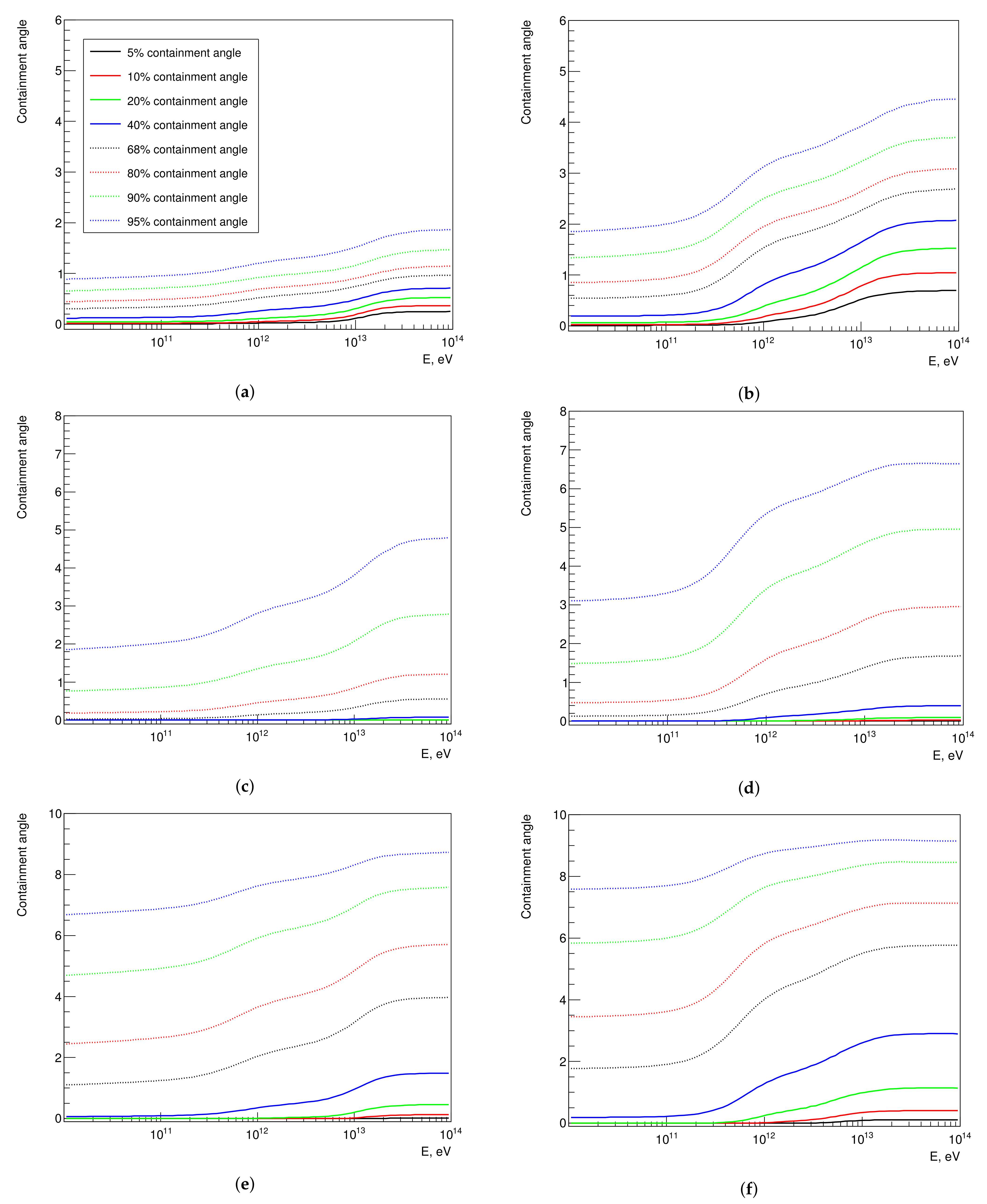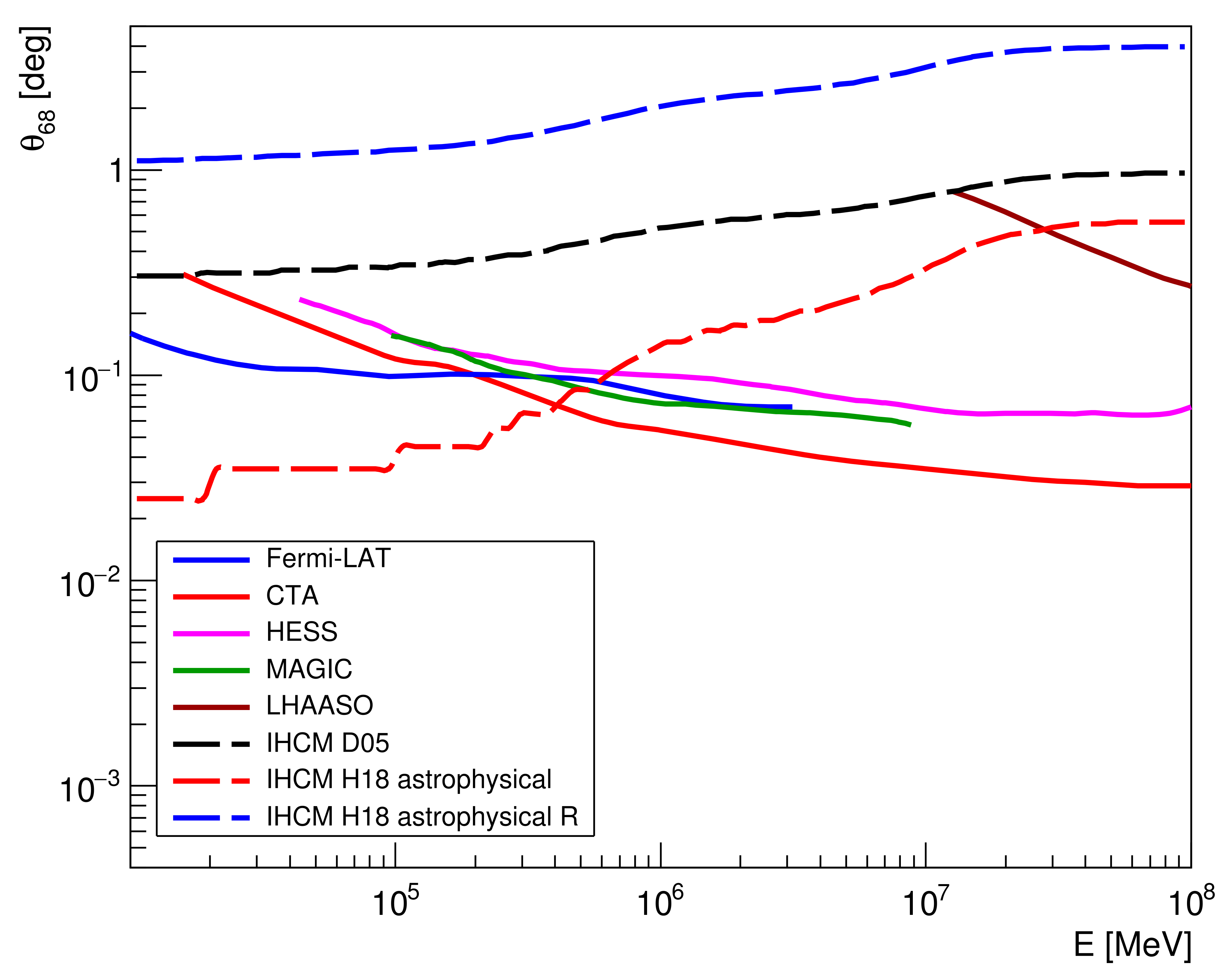Modeling Gamma-Ray SEDs and Angular Extensions of Extreme TeV Blazars from Intergalactic Proton-Initiated Cascades in Contemporary Astrophysical EGMF Models
Abstract
1. Introduction
2. EGMF Models
3. Simulation Methods
4. Results
5. Discussion and Conclusions
Funding
Institutional Review Board Statement
Informed Consent Statement
Acknowledgments
Conflicts of Interest
References
- Biteau, J.; Prandini, E.; Costamante, L.; Lemoine, M.; Padovani, P.; Pueschel, E.; Resconi, E.; Tavecchio, F.; Taylor, A.; Zech, A. Progress in unveiling extreme particle acceleration in persistent astrophysical jets. Nat. Astron. 2020, 4, 124–131. [Google Scholar] [CrossRef]
- Horns, D.; Meyer, M. Indications for a pair-production anomaly from the propagation of VHE gamma-rays. J. Cosmol. Astropart. Phys. 2012, 2012, 033. [Google Scholar] [CrossRef][Green Version]
- Korochkin, A.; Rubtsov, G.; Troitsky, S. Search for anomalous features in gamma-ray blazar spectra corrected for the absorption on the extragalactic background light. J. Cosmol. Astropart. Phys. 2019, 2019, 002. [Google Scholar] [CrossRef]
- Pontecorvo, B. Mesonium and anti-mesonium. Sov. Phys. Jetp 1957, 6, 429. [Google Scholar]
- Pontecorvo, B. Inverse beta processes and nonconservation of lepton charge. Zh. Eksp. Teor. Fiz. 1957, 34, 247. [Google Scholar]
- Pontecorvo, B. Neutrino Experiments and the Problem of Conservation of Leptonic Charge. Zh. Eksp. Teor. Fiz. 1967, 26, 1717–1725. [Google Scholar]
- Wolfenstein, L. Neutrino oscillations in matter. Phys. Rev. D 1978, 17, 2369–2374. [Google Scholar] [CrossRef]
- Wolfenstein, L. Neutrino oscillations and stellar collapse. Phys. Rev. D 1979, 20, 2634–2635. [Google Scholar] [CrossRef]
- Mikheyev, S.P.; Smirnov, A.Y. Resonance enhancement of oscillations in matter and solar neutrino spectroscopy. Yad. Fiz. 1985, 42, 1441–1448. [Google Scholar]
- Mikheyev, S.P.; Smirnov, A.Y. Resonant amplification of ν oscillations in matter and solar-neutrino spectroscopy. Il Nuovo Cim. C 1986, 9, 17–26. [Google Scholar] [CrossRef]
- Mikheev, S.P.; Smirnov, A.I. Neutrino oscillations in a medium with variable density and θ-flares from gravitational collapses of stars. Zhurnal Eksperimentalnoi I Teor. Fiz. 1986, 91, 7–13. [Google Scholar]
- Raffelt, G.; Stodolsky, L. Mixing of the photon with low-mass particles. Phys. Rev. D 1988, 37. [Google Scholar] [CrossRef]
- De Angelis, A.; Roncadelli, M.; Mansutti, O. Evidence for a new light spin-zero boson from cosmological gamma-ray propagation? Phys. Rev. D 2007, 76. [Google Scholar] [CrossRef]
- Sánchez-Conde, M.A.; Paneque, D.; Bloom, E.; Prada, F.; Domínguez, A. Hints of the existence of axionlike particles from the gamma-ray spectra of cosmological sources. Phys. Rev. D 2009, 79. [Google Scholar] [CrossRef]
- Kartavtsev, A.; Raffelt, G.; Vogel, H. Extragalactic photon-ALP conversion at CTA energies. J. Cosmol. Astropart. Phys. 2017, 2017, 024. [Google Scholar] [CrossRef]
- Montanino, D.; Vazza, F.; Mirizzi, A.; Viel, M. Enhancing the Spectral Hardening of Cosmic TeV Photons by Mixing with Axionlike Particles in the Magnetized Cosmic Web. Phys. Rev. Lett. 2017, 119. [Google Scholar] [CrossRef]
- Galanti, G.; Roncadelli, M. Behavior of axionlike particles in smoothed out domainlike magnetic fields. Phys. Rev. D 2018, 98. [Google Scholar] [CrossRef]
- Galanti, G.; Tavecchio, F.; Roncadelli, M.; Evoli, C. Blazar VHE spectral alterations induced by photon–ALP oscillations. Mon. Not. R. Astron. Soc. 2019, 487, 123–132. [Google Scholar] [CrossRef]
- Dessert, C.; Long, A.J.; Safdi, B.R. No evidence for axions from Chandra observation of magnetic white dwarf. arXiv 2021, arXiv:2104.12772. [Google Scholar]
- Abramowski, A.; Acero, F.; Aharonian, F.; Benkhali, F.A.; Akhperjanian, A.G. Constraints on axionlike particles with H.E.S.S. from the irregularity of the PKS2155-304energy spectrum. Phys. Rev. D 2013, 88. [Google Scholar] [CrossRef]
- Ajello, M.; Albert, A.; Anderson, B.; Baldini, L.; Barbiellini, G. Search for Spectral Irregularities due to Photon–Axionlike-Particle Oscillations with the Fermi Large Area Telescope. Phys. Rev. Lett. 2016, 116. [Google Scholar] [CrossRef] [PubMed]
- Libanov, M.; Troitsky, S. On the impact of magnetic-field models in galaxy clusters on constraints on axion-like particles from the lack of irregularities in high-energy spectra of astrophysical sources. Phys. Lett. B 2020, 802, 135252. [Google Scholar] [CrossRef]
- The CAST Collaboration. New CAST limit on the axion–photon interaction. Nat. Phys. 2017, 13, 584–590. [Google Scholar] [CrossRef]
- Berezinsky, V.S.; Smirnov, A.Y. Cosmic neutrinos of ultra-high energies and detection possibility. Astrophys. Space Sci. 1975, 32, 461–482. [Google Scholar] [CrossRef]
- Protheroe, R.J. Effect of electron-photon cascading on the observed energy spectra of extragalactic sources of ultra-high-energy -rays. Mon. Not. R. Astron. Soc. 1986, 221, 769–788. [Google Scholar] [CrossRef]
- Protheroe, R.J.; Stanev, T. Electron-photon cascading of very high-energy gamma-rays in the infrared background. Mon. Not. R. Astron. Soc. 1993, 264, 191–200. [Google Scholar] [CrossRef][Green Version]
- Aharonian, F.A.; Coppi, P.S.; Voelk, H.J. Very high energy gamma rays from active galactic nuclei: Cascading on the cosmic background radiation fields and the formation of pair halos. Astrophys. J. 1994, 423, L5. [Google Scholar] [CrossRef]
- Aharonian, F.A.; Akhperjanian, A.G.; Barrio, J.A.; Bernlöhr, K.; Bojahr, H. The time averaged TeV energy spectrum of MKN 501 of the extraordinary 1997 outburst as measured with the stereoscopic Cherenkov telescope system of HEGRA. Astron. Astrophys. 1999, 349, 11–28. [Google Scholar]
- Aharonian, F.A.; Timokhin, A.N.; Plyasheshnikov, A.V. On the origin of highest energy gamma-rays from Mkn 501. Astron. Astrophys. 2002, 384, 834–847. [Google Scholar] [CrossRef][Green Version]
- Waxman, E.; Coppi, P. Delayed GeV-TeV Photons from Gamma-Ray Bursts Producing High-Energy Cosmic Rays. Astrophys. J. 1996, 464, L75. [Google Scholar] [CrossRef]
- Uryson, A.V. Possible observation of electromagnetic cascades in extragalactic space. J. Exp. Theor. Phys. 1998, 86, 213–219. [Google Scholar] [CrossRef]
- Dzhatdoev, T.A.; Khalikov, E.V.; Kircheva, A.P.; Lyukshin, A.A. Electromagnetic cascade masquerade: A way to mimicγ-axion-like particle mixing effects in blazar spectra. Astron. Astrophys. 2017, 603, A59. [Google Scholar] [CrossRef]
- Hackstein, S.; Vazza, F.; Brüggen, M.; Sorce, J.G.; Gottlöber, S. Simulations of ultra-high energy cosmic rays in the local Universe and the origin of cosmic magnetic fields. Mon. Not. R. Astron. Soc. 2018, 475, 2519–2529. [Google Scholar] [CrossRef]
- Dolag, K.; Grasso, D.; Springel, V.; Tkachev, I. Constrained simulations of the magnetic field in the local Universe and the propagation of ultrahigh energy cosmic rays. J. Cosmol. Astropart. Phys. 2005, 2005, 009. [Google Scholar] [CrossRef]
- The CTA Consortium. Science with the Cherenkov Telescope Array; World Scientific: Singapore, 2018. [Google Scholar] [CrossRef]
- Bai, X.; Bi, B.Y.; Bi, X.J.; Cao, Z.; Chen, S.Z. The Large High Altitude Air Shower Observatory (LHAASO) Science White Paper. arXiv 2019, arXiv:1905.02773. [Google Scholar]
- Kulsrud, R.M.; Cen, R.; Ostriker, J.P.; Ryu, D. The Protogalactic Origin for Cosmic Magnetic Fields. Astrophys. J. 1997, 480, 481–491. [Google Scholar] [CrossRef]
- Ryu, D.; Kang, H.; Biermann, P.L. Cosmic magnetic fields in large scale filaments and sheets. arXiv 1998, arXiv:astro-ph/astro-ph/9803275. [Google Scholar]
- Sigl, G.; Miniati, F.; Enßlin, T.A. Ultrahigh energy cosmic ray probes of large scale structure and magnetic fields. Phys. Rev. D 2004, 70. [Google Scholar] [CrossRef]
- Das, S.; Kang, H.; Ryu, D.; Cho, J. Propagation of Ultra–High-Energy Protons through the Magnetized Cosmic Web. Astrophys. J. 2008, 682, 29–38. [Google Scholar] [CrossRef]
- Hackstein, S.; Vazza, F.; Brüggen, M.; Sigl, G.; Dundovic, A. Propagation of ultrahigh energy cosmic rays in extragalactic magnetic fields: A view from cosmological simulations. Mon. Not. R. Astron. Soc. 2016, 462, 3660–3671. [Google Scholar] [CrossRef]
- Sorce, J.G.; Gottlöber, S.; Yepes, G.; Hoffman, Y.; Courtois, H.M.; Steinmetz, M.; Tully, R.B.; Pomarède, D.; Carlesi, E. Cosmicflows Constrained Local UniversE Simulations. Mon. Not. R. Astron. Soc. 2015, 455, 2078–2090. [Google Scholar] [CrossRef][Green Version]
- Eichmann, B. High Energy Cosmic Rays from Fanaroff-Riley radio galaxies. J. Cosmol. Astropart. Phys. 2019, 2019, 009. [Google Scholar] [CrossRef]
- Alves Batista, R.; Dundovic, A.; Erdmann, M.; Kampert, K.H.; Kuempel, D.; Müller, G.; Sigl, G.; van Vliet, A.; Walz, D.; Winchen, T. CRPropa 3-a public astrophysical simulation framework for propagating extraterrestrial ultra-high energy particles. J. Cosmol. Astropart. Phys. 2016, 2016, 038. [Google Scholar] [CrossRef]
- Gilmore, R.C.; Somerville, R.S.; Primack, J.R.; Domínguez, A. Semi-analytic modelling of the extragalactic background light and consequences for extragalactic gamma-ray spectra. Mon. Not. R. Astron. Soc. 2012, 422, 3189–3207. [Google Scholar] [CrossRef]
- Protheroe, R.; Biermann, P. A new estimate of the extragalactic radio background and implications for ultra-high-energy γ-ray propagation. Astropart. Phys. 1996, 6, 45–54. [Google Scholar] [CrossRef]
- Berezinsky, V.; Kalashev, O. High-energy electromagnetic cascades in extragalactic space: Physics and features. Phys. Rev. D 2016, 94. [Google Scholar] [CrossRef]
- Kachelrieß, M.; Ostapchenko, S.; Tomàs, R. ELMAG: A Monte Carlo simulation of electromagnetic cascades on the extragalactic background light and in magnetic fields. Comput. Phys. Commun. 2012, 183, 1036–1043. [Google Scholar] [CrossRef]
- Kelner, S.R.; Aharonian, F.A. Energy spectra of gamma rays, electrons, and neutrinos produced at interactions of relativistic protons with low energy radiation. Phys. Rev. D 2008, 78. [Google Scholar] [CrossRef]
- Berezinsky, V.; Gazizov, A.; Grigorieva, S. On astrophysical solution to ultrahigh energy cosmic rays. Phys. Rev. D 2006, 74. [Google Scholar] [CrossRef]
- Aharonian, F.; Akhperjanian, A.G.; de Almeida, U.B.; Bazer-Bachi, A.R.; Behera, B. New constraints on the mid-IR EBL from the HESS discovery of VHE γ-rays from 1ES 0229+200. Astron. Astrophys. 2007, 475, L9–L13. [Google Scholar] [CrossRef]
- Aliu, E.; Archambault, S.; Arlen, T.; Aune, T.; Behera, B. A three-year multi-wavelength study of the very-high-energy γ-ray blazar 1ES 0229+200. Astrophys. J. 2014, 782, 13. [Google Scholar] [CrossRef]
- Abramowski, A.; Acero, F.; Aharonian, F.; Akhperjanian, A.G.; Anton, G. Discovery of hard-spectrumγ-ray emission from the BL Lacertae object 1ES 0414+009. Astron. Astrophys. 2012, 538, A103. [Google Scholar] [CrossRef]
- Primack, J.R. Observational Gamma-ray Cosmology. In Proceedings of the AIP Conference Proceedings, Salt Lake City, UT, USA, 10–11 August 2005. [Google Scholar] [CrossRef]
- Kneiske, T.M.; Bretz, T.; Mannheim, K.; Hartmann, D.H. Implications of cosmological gamma-ray absorption. Astron. Astrophys. 2004, 413, 807–815. [Google Scholar] [CrossRef]
- Atwood, W.B.; Abdo, A.A.; Ackermann, M.; Althouse, W.; Anderson, B. The Large area telescope on thefermi gamma-ray space telescopemission. Astrophys. J. 2009, 697, 1071–1102. [Google Scholar] [CrossRef]
- Aharonian, F.; An, Q.; Axikegu; Bai, L.X.; Bai, Y.W.; Bao, D.; Bastieri, X.J.; Bi, Y.J.; Bi, H.; Cai, J.T.; et al. The observation of the Crab Nebula with LHAASO-KM2A for the performance study. arXiv 2021, arXiv:2010.06205. [Google Scholar]
- Krennrich, F.; Bond, I.; Boyle, P.; Bradbury, S.; Buckley, J. VERITAS: The Very Energetic Radiation Imaging Telescope Array System. New Astron. Rev. 2004, 48, 345–349. [Google Scholar] [CrossRef]
- Park, N. Performance of the VERITAS experiment. In Proceedings of the 34th International Cosmic Ray Conference—PoS(ICRC2015), The Hague, The Netherlands, 30 July–6 August 2015. [Google Scholar] [CrossRef]
- Broderick, A.E.; Chang, P.; Pfrommer, C. The cosmological impact of luminous Tev blazars. I. implications of plasma instabilities for the intergalactic magnetic field and extragalactic gamma-ray background. Astrophys. J. 2012, 752, 22. [Google Scholar] [CrossRef]
- Pohl, M.; Hoshino, M.; Niemiec, J. PIC simulation methods for cosmic radiation and plasma instabilities. Prog. Part. Nucl. Phys. 2020, 111, 103751. [Google Scholar] [CrossRef]
- Khalikov, E.V.; Dzhatdoev, T.A. Observable spectral and angular distributions of γ-rays from extragalactic ultrahigh energy cosmic ray accelerators: The case of extreme TeV blazars. Mon. Not. R. Astron. Soc. 2021, 505, 1940–1953. [Google Scholar] [CrossRef]





Publisher’s Note: MDPI stays neutral with regard to jurisdictional claims in published maps and institutional affiliations. |
© 2021 by the author. Licensee MDPI, Basel, Switzerland. This article is an open access article distributed under the terms and conditions of the Creative Commons Attribution (CC BY) license (https://creativecommons.org/licenses/by/4.0/).
Share and Cite
Khalikov, E. Modeling Gamma-Ray SEDs and Angular Extensions of Extreme TeV Blazars from Intergalactic Proton-Initiated Cascades in Contemporary Astrophysical EGMF Models. Universe 2021, 7, 220. https://doi.org/10.3390/universe7070220
Khalikov E. Modeling Gamma-Ray SEDs and Angular Extensions of Extreme TeV Blazars from Intergalactic Proton-Initiated Cascades in Contemporary Astrophysical EGMF Models. Universe. 2021; 7(7):220. https://doi.org/10.3390/universe7070220
Chicago/Turabian StyleKhalikov, Emil. 2021. "Modeling Gamma-Ray SEDs and Angular Extensions of Extreme TeV Blazars from Intergalactic Proton-Initiated Cascades in Contemporary Astrophysical EGMF Models" Universe 7, no. 7: 220. https://doi.org/10.3390/universe7070220
APA StyleKhalikov, E. (2021). Modeling Gamma-Ray SEDs and Angular Extensions of Extreme TeV Blazars from Intergalactic Proton-Initiated Cascades in Contemporary Astrophysical EGMF Models. Universe, 7(7), 220. https://doi.org/10.3390/universe7070220





